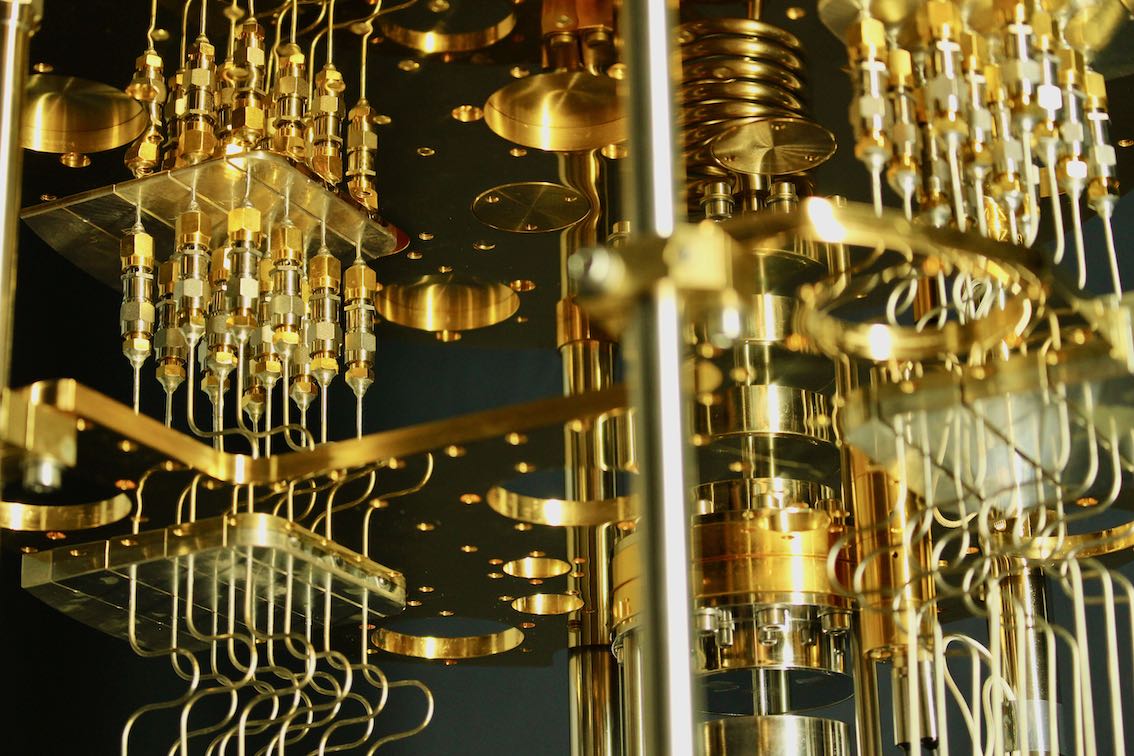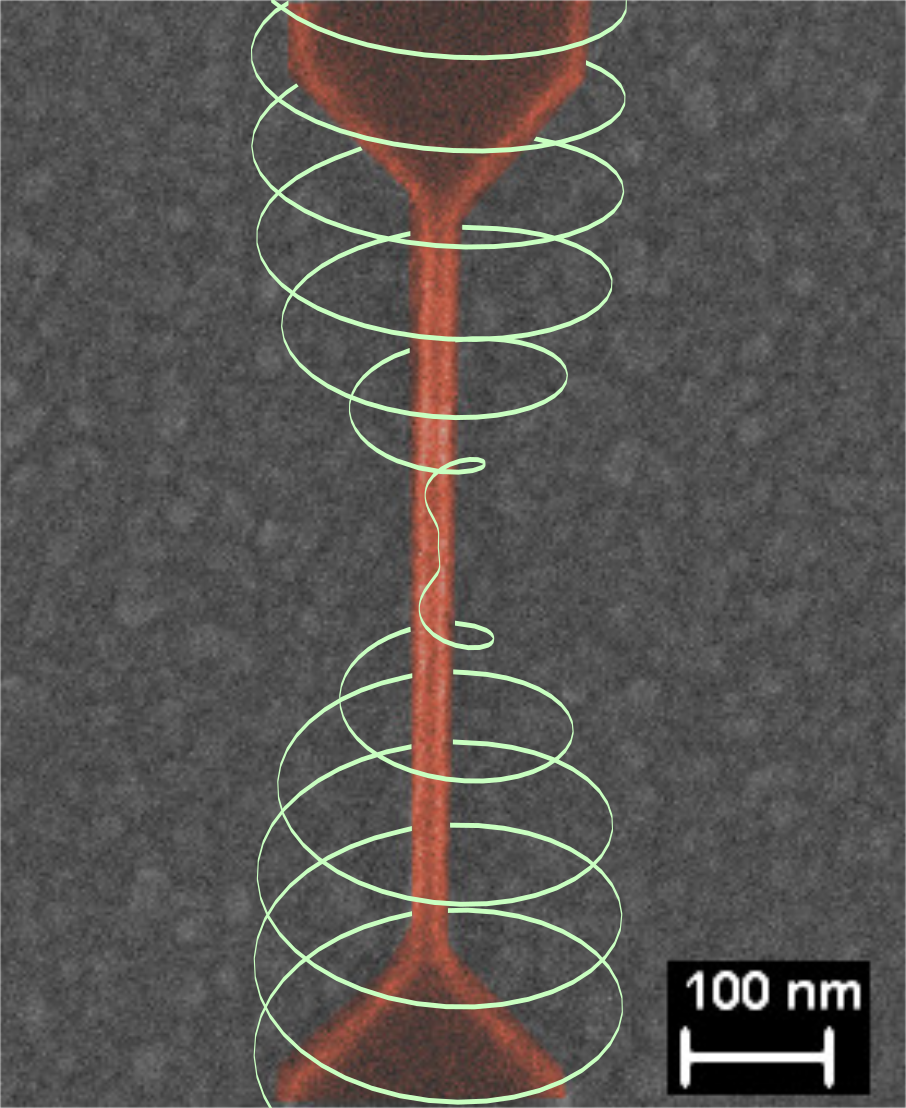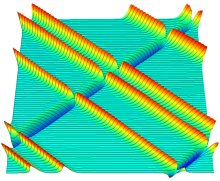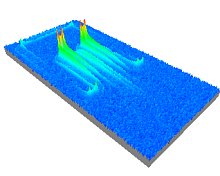Superconducting quantum circuits
At very low temperatures, superconducting circuits behave as macroscopic artificial atoms interacting with photons at microwave frequencies. The condensate of electrons in a superconductor behaves as single entity labeled by a quantum mechanical wave function. Superconducting quantum circuits employing Josephson junctions became recently the favorite hardware for building quantum computers.
In our group we study a wide range of physical phenomena employing superconducting quantum circuits. Our studies span from fundamental questions regarding quantum dynamics and many-body quantum systems to decoherence processes relevant for applications in quantum computing. Our lab works involve extremely sensitive microwave and dc measurements at millikelvin temperatures, design and modelling of the circuits, and their microfabrication in a clean room.
Students are always welcome for Bachelor, Master or PhD positions.
Superconducting qubits
Superconducting quantum bits (qubits) are the most promising candidates for building quantum computers.
In our group, we simulate, design, fabricate and measure superconducting qubits - including their varieties of phase, flux and transmon qubits.
The qubits are controlled by local magnetic fields to change the energy difference between their quantum eigenstates (|0> and |1>). We use few-nanosecond long microwave pulses to manipulate qubit quantum states. As the photon frequency corresponding to the typical energy difference between the qubit states is in the range of several GHz, the temperature of the circuit during our experiments has to be kept in the millikelvin range to avoid thermal population of the excited states.
Our research interests range from new qubit readout techniques, innovative qubit designs (Feofanov et al. 2010, Braumüller et al. 2015), novel qubit materials (Schön et al. 2020) to quantum metamaterials and quantum simulators (see below).
In 2011, our group pioneered frequency-multiplexed readout of multiple qubits via a single microwave line (Jerger et al, 2011) – the crucial step towards scalable quantum computer architecture.
To develop our circuits, we employ quantum and electromagnetic circuit simulation kits. We fabricate our quantum chips using on-campus facilities (Nanostructure Service Laboratory) and measure them in our dilution refrigerators using advanced microwave instruments and hardware programming tools.
Decoherence mechanisms
Superconducting qubits are fabricated similarly to conventional semiconductor microcircuits. Thus, it is in principle straight-forward to make dozens of qubits on a chip and wire them up to realize a quantum processor. However, high connectivity and solid-state integration make it difficult to protect the qubits from undesired environmental interactions which disturb their quantum states and cause decoherence.
Often, the fluctuations of microscopic defects located near the electrodes of a qubit circuit are the dominant source of decoherence. To avoid such defects, we are developing advanced fabrication recipes (Stehli et al., 2020) and investigate novel materials for improved qubit coherence (Winkel et al., 2019). Yet, also the impact of cosmic particles on a qubit chip can be detrimental as we have shown (Cardani et al., 2020). To study decoherence mechanisms in detail, we also couple qubits to custom-tailored environments realized from discrete microwave resonators
Two-level defects
A particular problem of superconducting qubits are interactions with microscopic two-level-systems (TLS). TLS are formed when a few atoms in a disordered material switch between two lattice positions by quantum tunneling. Such tunneling defects act like parasitic qubits which may absorb energy from a superconducting qubit and cause decoherence (Schlör et al., 2019). To improve qubits, it will be vital to understand how TLS emerge in device fabrication and how they can be avoided (Müller, Cole and Lisenfeld, 2015).
At KIT, we have pioneered various methods to investigate the origins and dynamics of TLS. We use qubits as tools to control and detect the quantum states of individual TLS defects. By manipulating TLS with applied mechanical strain (Grabovskij et al., 2012) and resonant microwave excitation (Lisenfeld et al., 2010), we can measure their frequency distribution, study their quantum dynamics (Lisenfeld et al., 2016), and investigate systems of mutually interacting TLS (Lisenfeld et al., 2015). Moreover, tuning TLS with applied electric fields allows us to determine the positions of individual defects in a qubit circuit (Bilmes et al., 2019). This shows how defects emerge in sample fabrication and guides our way towards more coherent qubits.
For questions concerning Bachelor- Master or PhD-thesis, please contact Jürgen Lisenfeld or Alexander Bilmes
[1] David P.DiVincenzo. The physical implementation of quantum computation. Fortschr. Phys., 48:1931–1951, 2000.
[2] W. A. Phillips. J. Low Temp. Phys., 7, 1972.
[3] C. M. Varma P. W. Anderson, B. I. Halperin. Philos. Mag., 25, 1972.
[4] R. W. Simmonds, K. M. Lang, D. A. Hite, S. Nam, D. P. Pappas, and John M. Martinis. Decoherence in josephson phase qubits from junction resonators. Phys. Rev. Lett., 93:077003, Aug 2004.
[5] Grigorij J. Grabovskij, Torben Peichl, Juergen Lisenfeld, Georg Weiss, and Alexey V. Ustinov. Strain tuning of individual atomic tunneling systems detected by a superconducting qubit. Science, 338(6104):232–234, 2012.
[6] Jürgen Lisenfeld, Grigorij J. Grabovskij, Clemens Müller, Jared H. Cole, Georg Weiß, and Alexey V. Ustinov. Observation of directly interacting coherent two-level systems in an amorphous material. To be published.
[7] Coherent Josephson Qubit Suitable for Scalable Quantum Integrated Circuits, Phys. Rev. Lett. 111, 080502 – 22 Aug 2013
Quantum Phase Slips in superconducting nano-wires
Mooij, J. E.; Schön, G.; Shnirman, A.; Fuse, T.; Harmans, C. J. P. M.; Rotzinger, H.; Verbruggen, A. H.
2015. New Journal of Physics, 17, 033006. doi:10.1088/1367-2630/17/3/033006 x
Solitons in Josephson junctions
Soliton propagation is an interesting field in various contexts within nonlinear physics.
A unique feature of long Josephson junctions is that they allow the experimental study of soliton dynamics with a great degree of precision, impossible for many other physical systems with solitons.
A soliton in a Josephson junction accounts for a magnetic flux quantum moving between two superconducting electrodes. Mathematically, it is described by a solitarywave solution of the sine-Gordon equation which models the electromagnetic wave propagation in the junction.v
A soliton in a Josephson junction accounts for a magnetic flux quantum moving between two superconducting electrodes. Mathematically, it is described by a solitarywave solution of the sine-Gordon equation which models the electromagnetic wave propagation in the junction.
When increasing the bias current, the soliton velocity increases and approaches the velocity of light in the junction (so-called Swihart velocity). This velocity is about 30 times smaller than the light velocity in vacuum. The soliton has all characteristic properties of a relativistic particle. Thus, here we can experimentally study the relativistic dynamics in a volume of less than 1 cm3!
Imaging sources of dissipation and nonlinearity in superconductors
The superconducting state has unique features for realizing compact solid-state devices with controllable macroscopic quantum properties and long coherence time.
Investigation of intrinsic origins of the nonlinear behavior and energy losses in superconducting structures at microwave frequencies has both fundamental and practical relevance. In particular, it is important to identify the local sources of nonlinearity associated with the global nonlinear response of superconducting structures irradiated by microwaves.
We apply a high-resolution, nondestructive evaluation technique of low-temperature laser scanning microscopy to the investigation of local microwave properties of superconducting thin-film circuits. In this technique, a modulated laser beam is focused onto and scanned over the surface of a resonant superconducting device to probe the spatial distribution of microwave currents.
The spatially localized photo-induced change of the kinetic inductance of the device produces both a shift of the resonant frequency and change of the quality factor. An image of these changes is recorded as the laser spot is scanned over the device. By using a newly developed procedure of spatially-resolved wave impedance partition, the influence of inhomogeneous current flow on the formation of nonlinear microwave response in such planar devices is analyzed in terms of the independent impact from resistive and inductive components. The capability of our method to probe the spatial variations of two-tone, third-order intermodulation currents on micron length scales is used to find the 2D distribution of the local sources of nonlinear response.











